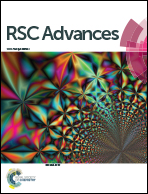Highly stretchable fiber-based single-electrode triboelectric nanogenerator for wearable devices†
Abstract
Fiber- or thread-based triboelectric nanogenerators are suitable for wearable applications such as clothes embedded with communication devices or other electronic textiles. Unfortunately, previously reported fiber-based triboelectric nanogenerators had poor stretchability, because of which they were not suitable for weaving applications. In this paper, we propose a new structure of a fiber-based single-electrode triboelectric nanogenerator (FSTENG). The proposed FSTENG uses silicone rubber as the negative part and a conductive thread as the electrode of the TENG. The electrical output of the FSTENG is generated by the continuous contact and separation between human skin and silicone rubber. A prototype of the proposed FSTENG showed an electrical output of 28 V and 0.56 μA, when in contact with human skin, and exhibited a high strain of up to 100%. In addition, we fabricated a woven structure with dimensions of 45 mm × 45 mm, incorporating the FSTENG, and confirmed its power generation capabilities using LEDs and an electronic watch. The proposed FSTENG can be applied to various products ranging from wearable and stretchable energy harvesters to smart clothing, by facilitating the manufacture of large textiles.



 Please wait while we load your content...
Please wait while we load your content...